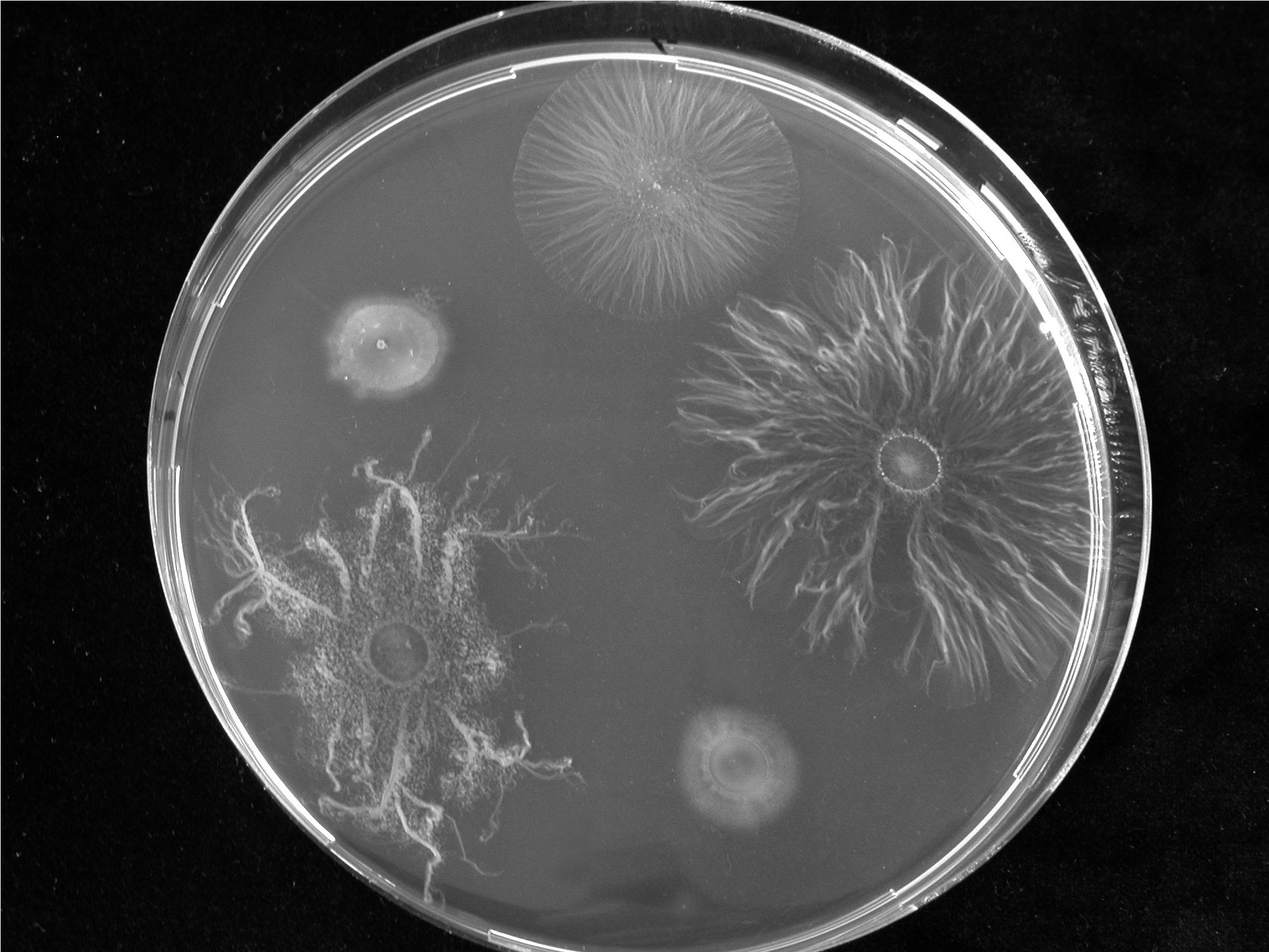
Background
Organisms often migrate actively, for example to seek food or avoid dangers. When migrations span multiple generations, as often occurs during microbial motility, populations can evolve while migrating.
Many factors in extremely variable soil habitats can be expected to influence the fitness, and thus the evolution, of actively motile microbes.
MyxoEE-3 was designed to ask how variation in several abiotic and biotic ecological factors and in ancestral motility genotypes impact how swarming populations of M. xanthus evolve across a suite of traits. These traits include both some likely to be under direct selection in a particular environment and others that may evolve indirectly, for example due to pleiotropic effects of adaptive evolution.
Historical anecdote - An early version of what would become MyxoEE-3 was run in the late 1990s, but the experiment was redesigned and expanded into the version run from 2001-2003.
Design summary: Over two-week cycles, M. xanthus populations descended from three distinct ancestors that differed in their motility-related genotypes swarmed radially on agar plates varying in firmness, nutrient availability and nutrient identity - including the presence or absence of prey and prey identity - until a sample of the distal-most swarm region was transferred to a new plate.
Highlights
Behavioral innovation - Co-option of a functionally limited motility system enables the evolution of novel swarming abilities.
Shifting backgrounds - Genome evolution reverses the direction of a social gene’s effect on motility, shifts its pleiotropic spectrum and repeatedly generates negative epistasis between the gene and evolved mutations.
Allopatric social diversification - Allopatric evolution creates social incompatibilities, social-fitness inequalities, and genotypic barriers to cheating.
Phenotypic radiation - Chance, environment, history and time interact to create seemingly “endless forms most beautiful and wonderful” (Darwin 1959), including for phenotypes of multicellular development and group motility.
Run or fight? - During competition for open resource-rich territory, both outrunning and outfighting competitors can evolve under the same conditions.
Latent diversification of susceptibilty to viruses - Chance dominates over selection during virus-blind diversification of susceptibility to lethal phage infection. Lab evolution increases resistance to phage.
Predator diet shapes morphological evolution - Resource and prey identity latently determine the evolution of predator morphology.
Publications
Velicer, G. J. and Y.-T. N. Yu. 2003. Evolution of novel cooperative swarming in the bacterium Myxococcus xanthus. Nature. READ IT HERE
Zee, P. C., H. Mendes-Soares, Y.-T. N. Yu, H. Keller, S. A. Kraemer, S. Ossowski, K. Schneeberger and G. J. Velicer. 2014. A shift from magnitude to sign epistasis during adaptive evolution of a bacterial social trait. Evolution. READ IT HERE
Rendueles, O., P. C. Zee, I. Dinkelacker, M. Amherd, S. Wielgoss and G. J. Velicer. 2015. Rapid and widespread de novo evolution of kin discrimination. Proceedings of the National Academy of Sciences USA. READ IT HERE
Zee, P. C., J. Liu and G. J. Velicer. 2017. Pervasive, yet idiosyncratic, epistatic pleiotropy during adaptation in a behaviourally complex microbe. Journal of Evolutionary Biology. READ IT HERE
Rendueles, O., and G. J. Velicer. 2017. Evolution by flight and fight: diverse mechanisms of adaptation by actively motile microbes. The ISME Journal. READ IT HERE
Zee, P. C. and G. J. Velicer. 2017. Parallel emergence of negative epistasis across experimental lineages. Evolution. READ IT HERE
Nair, R. R., F. Fiegna and G. J. Velicer. 2018. Indirect evolution of social fitness inequalities and facultative social exploitation. Proceedings of the Royal Society B. READ IT HERE
Rendueles, O. and G. J. Velicer. 2020. Hidden paths to endless forms most wonderful: Complexity of bacterial motility shapes diversification of latent phenotypes. BMC Evolutionary Biology. READ IT HERE
Freund, L., M. Vasse and G. J. Velicer. 2021. Hidden paths to endless forms most wonderful: Parasite-blind diversification of host quality. Proceedings of the Royal Society B. READ IT HERE
La Fortezza, M., O. Rendueles, H. Keller and G. J. Velicer. 2022. Hidden paths to endless forms most wonderful: Ecology latently shapes evolution of multicellular development in predatory bacteria. Communications Biology. READ IT HERE
Schaal, K. A., Y.-T. N Yu, M. Vasse and G. J. Velicer. 2022. Allopatric divergence of cooperators confers cheating resistance and limits effects of a defector mutation. BMC Ecology and Evolution. READ IT HERE